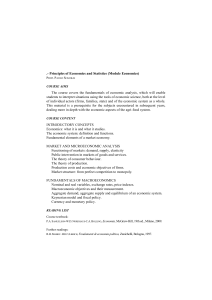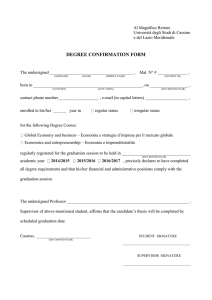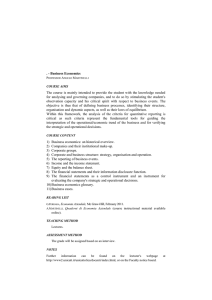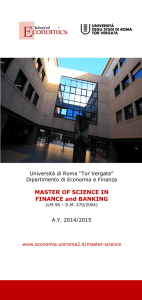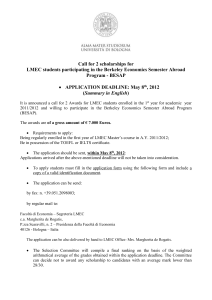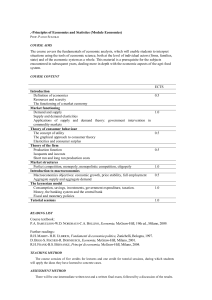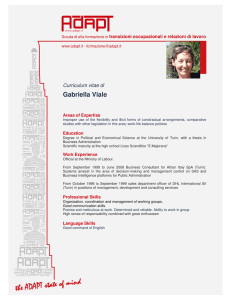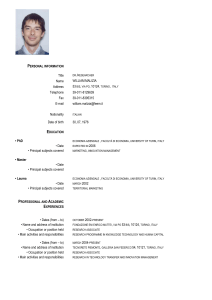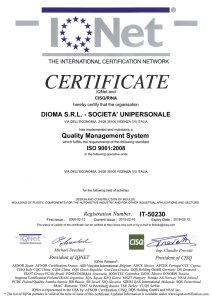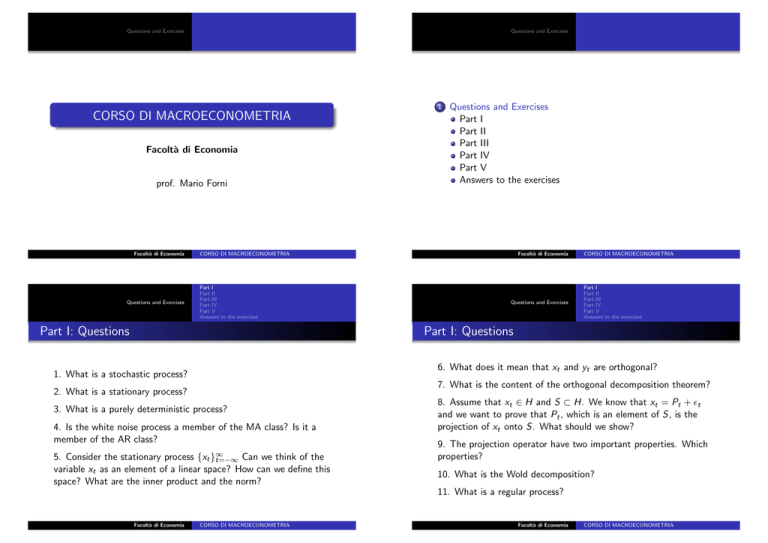
Questions and Exercises
Questions and Exercises
1
CORSO DI MACROECONOMETRIA
Facoltà di Economia
prof. Mario Forni
Facoltà di Economia
Questions and Exercises
Questions and Exercises
Part I
Part II
Part III
Part IV
Part V
Answers to the exercises
CORSO DI MACROECONOMETRIA
Part I
Part II
Part III
Part IV
Part V
Answers to the exercises
Part I: Questions
Facoltà di Economia
Questions and Exercises
CORSO DI MACROECONOMETRIA
Part I
Part II
Part III
Part IV
Part V
Answers to the exercises
Part I: Questions
6. What does it mean that xt and yt are orthogonal?
1. What is a stochastic process?
7. What is the content of the orthogonal decomposition theorem?
2. What is a stationary process?
3. What is a purely deterministic process?
4. Is the white noise process a member of the MA class? Is it a
member of the AR class?
{xt }∞
t=−∞
5. Consider the stationary process
Can we think of the
variable xt as an element of a linear space? How can we define this
space? What are the inner product and the norm?
8. Assume that xt ∈ H and S ⊂ H. We know that xt = Pt + t
and we want to prove that Pt , which is an element of S, is the
projection of xt onto S. What should we show?
9. The projection operator have two important properties. Which
properties?
10. What is the Wold decomposition?
11. What is a regular process?
Facoltà di Economia
CORSO DI MACROECONOMETRIA
Facoltà di Economia
CORSO DI MACROECONOMETRIA
Questions and Exercises
Part I
Part II
Part III
Part IV
Part V
Answers to the exercises
Part I: Exercises
Questions and Exercises
Part I
Part II
Part III
Part IV
Part V
Answers to the exercises
Part II: Questions
1. Show that t + 2t−1 is stationary if t ∼ w .n..
1. What is a two-sided filter in L?
2.* Consider the process xt = 0.5xt−1 + t , where t ⊥ xt−k ,
k > 0, E t = 0. Show that t is a white noise process.
2. What is the invertibility condition for a(L)?
3. Consider the process of Exercise 2. What is the projection of xt
onto span(xt−1 )? What is the projection of xt onto
span(xt−1 , xt−2 , . . .)?
4. What does it mean that xt = 0.5xt−1 + t , t ∼ w.n., is
stationary?
4. Consider the process of Exercise 2. What is the best linear
prediction of xt+1 , given the present and the past of xt ? What is
the best linear prediction of xt+1 ?
5. Consider the process xt = 1 + 0.4xt−1 + ηt , where
ηt = 0.1xt−1 + t , t ⊥ xt−1 . What is the projection of xt onto
span(1, xt−1 )?
Facoltà di Economia
Questions and Exercises
CORSO DI MACROECONOMETRIA
Part I
Part II
Part III
Part IV
Part V
Answers to the exercises
Part II: Exercises
3. What is a stochastic difference equation?
5. Consider the MA(1) process xt = (1 + aL)t , t ∼ w.n. What
does it mean that this representation is invertible? What is the
invertibility condition?
6. What is the covariance generating function? What is the sample
covariogram?
7. Describe a procedure for ARMA model selection and diagnostic
checking.
Facoltà di Economia
Questions and Exercises
CORSO DI MACROECONOMETRIA
Part I
Part II
Part III
Part IV
Part V
Answers to the exercises
Part III: Questions
1. Find the stationary solution of xt = 1 + 0.5xt−1 + t , t w.n.
What is the general solution?
1. What is the difference between a TS and a DS model?
2.* Consider the model in 1. Show that t ⊥ xt−k , k > 0. What is
the best linear prediction for xt+3 , given the present and the past
of xt ?
2. How can we interpret the number a(1) if ∆xt = a(L)t ,
a(0) = 1 is the Wold representation of ∆xt ?
3.* Factorize 1 − 1.5L + 0.5L2 . Is it invertible? Why?
3. What is an ARIMA(p,d,q) process?
4. Find the covariance generating function of the process
xt = (1 + 2L)t , t w.n.
4. How can we test whether a process is DS or TS?
5. Consider the process (1 − 1/3L)xt = µ + (1 − L)t , t w.n.
What is this process? Is it stationary? Is it regular? Is it invertible?
Find the Wold representation.
Facoltà di Economia
CORSO DI MACROECONOMETRIA
5. What is the Beveridge and Nelson decomposition? What is a
trend-cycle decomposition?
Facoltà di Economia
CORSO DI MACROECONOMETRIA
Questions and Exercises
Part I
Part II
Part III
Part IV
Part V
Answers to the exercises
Part III: Exercises
Questions and Exercises
Part I
Part II
Part III
Part IV
Part V
Answers to the exercises
Part IV: Questions
1. Consider the random walk with drift process ∆xt = a + t .
What is the optimal prediction for xt+1 given
span(xt , xt−1 , xt−2 , . . .)? What is the prediction for xt+k ?
2. Consider the TS process xt = b + at + t . t w.n. Compute
x̂t+k . What is the difference with respect to the prediction in 1?
3.* Consider the process d(L)∆xt = b + c(L)t , with c(1) = 0. Is
xt a DS or a TS process? Why?
4.* Write the Beveridge and Nelson decomposition for the process
∆xt = 4 + (1 + 0.5L − 0.5L2 )t .
5. Write the Beveridge and Nelson decomposition for
∆xt = 1 + (1 − L)t . Is the trend deterministic or stochastic?
Facoltà di Economia
Questions and Exercises
1. What does it mean that xt and yt are jointly stationary?
2. What is the stability condition for the Vector ARMA
B(L)zt = C (L)t ? What is the invertibility condition?
3. What is the cross-covariogram γkxy , k = −∞, ∞? What is the
relation between γ xy and γ yx ?
4. What is the law of iterated projections?
5. What does it mean that yt does not Granger-cause xt Write the
Wold representation of zt = (yt xt )0 when yt does not
Granger-cause xt .
CORSO DI MACROECONOMETRIA
Part I
Part II
Part III
Part IV
Part V
Answers to the exercises
Part IV: Exercises
Facoltà di Economia
Questions and Exercises
CORSO DI MACROECONOMETRIA
Part I
Part II
Part III
Part IV
Part V
Answers to the exercises
Part IV: Exercises
1.* Define the process ηt = t for t odd and ηt = ωt for t even,
where (t ηt )0 is a vector white noise, var(t ) = var(ωt ) = 1,
cov(t , ηt ) = 0. Is ηt a stationary process? are t and ηt jointly
stationary?
2. Consider the w.n. t and set ηt = t−1 . Is ηt w.n.? Are t and
ηt jointly w.n.?
5.* Show that ηt does not Granger-cause t in exercise 2, while t
Granger-causes ηt .
3. Find the auto-covariances and cross-covariances of
yt
1
L
t
=
xt
0.5L 1
etat
where σ2 = ση2 = 1 and ση = 0.
4. Find the AR(∞) representation for the process in 3.
Facoltà di Economia
CORSO DI MACROECONOMETRIA
Facoltà di Economia
CORSO DI MACROECONOMETRIA
Questions and Exercises
Part I
Part II
Part III
Part IV
Part V
Answers to the exercises
Part V: Questions
Questions and Exercises
Part I
Part II
Part III
Part IV
Part V
Answers to the exercises
Part V: Exercises
1. What does it mean that yt and xt are cointegrated?
2. What is the relation between the common-trend representation
and cointegration?
3. Can we say something about cointegration by looking at the
Wold representation of the first differences?
4. What is the relation between cointegration and the Error
Correction Mechanism?
1. Consider the process
∆yt
1
0.5L
t
=
∆xt
−L 1 − 1.5L
ηt
Are yt and xt cointegrated? why?
2. Find the common-trend representation for xt and yt starting
from
∆yt
1 −L
t
=
∆xt
−L 1
ηt
5. How can we test for cointegration?
3.* Find the ECM representation for the variables in 2.
Facoltà di Economia
Questions and Exercises
CORSO DI MACROECONOMETRIA
Facoltà di Economia
Part I
Part II
Part III
Part IV
Part V
Answers to the exercises
Part V: Exercises
Questions and Exercises
CORSO DI MACROECONOMETRIA
Part I
Part II
Part III
Part IV
Part V
Answers to the exercises
Part I
4.* Find the Wold representation for the first differences of the
variables
yt
Tt
=
+ t
xt
Tt
ηt
1. Either compute the autocovariances and show that they do not
depend on t, or simply argue that xt is a member of the Hilbert
space spanned by t−k , all k.
2. Write t−k = xt−k + 0.5xt−k−1 and compute cov(t , t−k ) for
k > 0.
3. 0.5xt−1 , since t ⊥ xt−1 ; 0.5xt−1 , since t ⊥ xt−k , k > 0.
where ∆Tt = t .
4. x̂t+1 = 0.5xt ; x̂t+2 = 0.25xt (apply the chain rule of
forecasting).
5. 1 + 0.5xt−1 .
Facoltà di Economia
CORSO DI MACROECONOMETRIA
Facoltà di Economia
CORSO DI MACROECONOMETRIA
Questions and Exercises
Part I
Part II
Part III
Part IV
Part V
Answers to the exercises
Part II
Part I
Part II
Part III
Part IV
Part V
Answers to the exercises
Questions and Exercises
Part II
1. The stationary solution is
xt = 2 + 1/(1 − 0.5L)t = 2 + (1 + 0.5L + 0.52 L2 + · · · )t . The
term 0.5t c must be added to get the general solution.
2. We have xt−k = 2 + 1/(1 − 0.5L)t−k . Since t ⊥ t−k for
k > 0, then t ⊥ xt−k , k > 0. We have x̂t+3 = 1 + 0.5x̂t+2 =
1 + 0.5 + 0.52 x̂t+1 = 1 + 0.5 + 0.52 + 0.53 xt = 1.75 + 0.125xt .
q
3. The roots are z ∗ = 23 ± 94 − 2 = 32 ± 12 which is either 1 or 2.
5. It is ARMA(1,1). It is stationary, regular, not invertible. The
Wold representation is
xt =
3µ
1−L
+
t .
2
1 − L/3
Hence 1 − 1.5L + 0.5L2 = (1 − L)(1 − 0.5L), which is not invertible
because of the factor (1 − L).
4. (1 + 2z)(1 + 2z −1 )σ2 = σ2 (5 + 2z −1 + 2z).
Facoltà di Economia
Questions and Exercises
CORSO DI MACROECONOMETRIA
Facoltà di Economia
Part I
Part II
Part III
Part IV
Part V
Answers to the exercises
Part III
CORSO DI MACROECONOMETRIA
Part I
Part II
Part III
Part IV
Part V
Answers to the exercises
Questions and Exercises
Part IV
1. x̂t+1 = a + xt ; x̂t+k = ak + xt ;
2. x̂t+k = b + at + ak. The main difference is that here the level
of xt does not matter.
3. It is a DS process, since we can write
xt = a +
c̃(L)
b
t+
t ,
d(1)
d(L)
1. ηt is stationary since it is w.n. t and ηt are not jointly
stationary, since cov(t , ηt ) = 1 for t odd and cov(t , ηt ) = 1 for t
odd and cov(t , ηt ) = 0 for t even.
2. ηt is w.n.; the vector (ηt t )0 is not w.n., since
cov(t , ηt−1 ) = σ2 6= 0.
3.
1
0.5z
where c̃(L) = c(L)/(1 − L) and a is an arbitrary constant.
4. ∆xt = (4 + t ) + (1 − L)(0.5L)t .
5. ∆xt = 1 + (1 − L)t . The trend is the deterministic trend a + t.
Facoltà di Economia
CORSO DI MACROECONOMETRIA
4.
z
1
1
z −1
0.5z −1
1
1
1−0.5L2
−L
2(1−0.5L2 )
−L
1−0.5L2
1
1−0.5L2
Facoltà di Economia
2
0.5z −1 + z
−1
0.5z + z
1.25
=
! yt
= t
xt
ηt
CORSO DI MACROECONOMETRIA
Questions and Exercises
Part I
Part II
Part III
Part IV
Part V
Answers to the exercises
Part IV
Questions and Exercises
Part I
Part II
Part III
Part IV
Part V
Answers to the exercises
Part V
1. Yes, they are. The determinant of the Wold impulse response
function matrix is 1 − 1.5L + 0.5L2 which vanishes for L = 1.
5. The projection of t onto the space spanned by the past of and η is 0. The projection of ηt onto the same space is t−1 .
2. The Beveridge and Nelson decomposition is
∆yt
1
0.5
t
0
−0.5(1 − L)
t
=
+
∆xt
−1 −0.5
ηt
1 − L 1.5(1 − L)
ηt
Hence we have
∆yt
∆Tt
0 −0.5
t
=
+ (1 − L)
∆xt
−∆Tt
1 1.5
ηt
where ∆Tt = t + 0.5ηt .
Facoltà di Economia
Questions and Exercises
Facoltà di Economia
CORSO DI MACROECONOMETRIA
Part I
Part II
Part III
Part IV
Part V
Answers to the exercises
Part V
Questions and Exercises
CORSO DI MACROECONOMETRIA
Part I
Part II
Part III
Part IV
Part V
Answers to the exercises
Part V
3. Premultiplying by the adjugate of C (L) we get
1 L
yt
= (1 + L) t
L 1
xt
ηt
Let A(L) be the matrix on the RHS. By subtracting to both sides
A(1)L(yt xt )0 we get
∆yt
1
=−
s
+ (1 + L) t
∆xt
1 t−1
ηt
where st = yt + xt .
Facoltà di Economia
CORSO DI MACROECONOMETRIA
4. We have
∆yt
2−L
0
t
= t + (1 − L) t =
∆xt
t
ηt
1
1−L
ηt
The determinant of the matrix on the RHS, let it be A(L), does
not have roots within the unit circle. Hence we have a
fundamental representation. Since the Wold matrix in 0 is the
identity matrix, the Wold matrix is C (L) = A(L)A(0)−1 and the
residuals are A(0)(t ηt )0 , i.e.
∆yt
1 − 0.5L
0
2t
=
∆xt
0.5L
1−L
t + ηt
Facoltà di Economia
CORSO DI MACROECONOMETRIA


